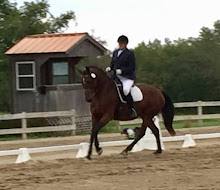Tuesday, February 4, 2014
Blending Torso, Leg and Rein aids for improving your horse's movement
Strategies for mixing torso, rein and leg aids to add volume to a horse’s movement.
When we, as riders, think about how to mix torso, rein and leg aid, the subject can seem overwhelming.
Here are some simple ideas on how to mix these aids:
The rider can come in with his/her torso tight and just hold it while half halting with the outside rein and pushing with the legs within the timing (not half halting for more than one beat). This helps a great deal to not get the horse locked in its neck or back. This applies to the walk and trot. But riders must remember to release their torso as the horse responds correctly to the half halts. As the horse improves its balance as a result of the half halt, the rider should loosen her/his torso for a reward. This works well for the walk and trot.
For the canter, the rider should hold only as the horse swings the rider’s hips forward and release as the horse swings the hips backwards. This helps the horse balance better without constricting it. This is in addition to alignment not instead of it. Relative straightness in the canter will allow your horse to have an uphill canter.
Over many years I have worked with many horses that are not warmbloods. These horses tend to need help in freedom of movement and collection both. As a result I have tried like crazy to aid them in the best possible timing and then release, and then aid them in the best possible timing and release . This builds their freedom in movement and then I ask for better balance and collection.
The rider needs flexion in the horse to one side or the other to define an outside rein. The half halt then comes through really well on the rein that is opposite of the bend.
This is required to a lesser degree on the loose moving warmbloods . They tend to really need more balancing then they need loosening. The rider will need their core engaged more to help them with their balance. I say this because if a rider has ridden mostly loose moving warmbloods, they are going to wonder what I am talking about.
For example, I have been working on piaffe on one horse for 6 - 9 months. She tends to stress. In the past she has sometimes stressed out and I would release her from the movement and try again. Now she is mature enough in her thoughts about Piaffe that last week when I approached it and she stressed out, I just stayed in the Piaffe request until she found her way there. This horse is an example of a loose moving warmblood. She was stressing and worrying about the balancing aid. She really needs the longitudinal balance help more than she needs help loosening her gait.
The approach to non- warmbloods is for me very different because they need to maximize their movement before they can be collected. When riding a loose moving warmblood, I can almost at the same time ask for more movement and better balance, but that would not work on a horse that had tighter movement. For a horse with tighter movement it is a step by step process.
I really enjoy loosening tight horses and then have the riders elevate them into collection.
Subscribe to:
Posts (Atom)
